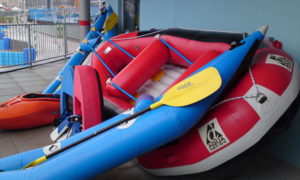White Water River Safety
 White water river safety should be at the forefront of everyone’s mind. Whether your taking a ride on a canoe through a small set of rapids that is labeled as a beginner set of rapids. Or the much more dangerous class 4 type rapids that only an expert should consider. Accidents happen and if you are well prepared, then you can deal with them easily and avoid anything serious. We will try to cover some of the essentials that you need to know before you go on your first white water rafting trip.
White water river safety should be at the forefront of everyone’s mind. Whether your taking a ride on a canoe through a small set of rapids that is labeled as a beginner set of rapids. Or the much more dangerous class 4 type rapids that only an expert should consider. Accidents happen and if you are well prepared, then you can deal with them easily and avoid anything serious. We will try to cover some of the essentials that you need to know before you go on your first white water rafting trip.
Always check with your guide. Use your own common sense as well to make sure that you can easily get out of any situation that might occur. Matching skill levels to the rapids is probably one of the most important areas to pay attention to. Some agencies will even have you conduct swimming tests to verify that you can swim. That you also have the stamina to deal with a whitewater situation that goes bad. Pay attention , they know what they are doing. Always wear a life preserver regardless of what anyone else is doing or even if they are making fun of you. They will be sorry if they end up in the water without one.
White Water River Safety – Some Guidelines
Research – Regardless of your skill level and the river advertisement, do some research about the water you will be on and assess based on the time of year as well as current conditions if it is something you can handle. Rivers change all the time based on local storms, time of year and even water release schedules from upstream dams.
Safety Gear – Either bring a safety jacket or make sure you are given one by the tour operator. Also wear a helmet to protect your head from rocks in case you are thrown out of the raft.
Water Tight Package – Especially required for overnight trips and even some half day trips, a water tight package with dry clothes, duct tape for sealing your package, rubbing alcohol for disinfecting wounds and a fire starter in case you are stranded and need to make a fire. The water tight package should be of strong plastic material and sealed so that water cannot get in even if it is submerged for some time.
Other Items – these items need to be kept together and it does not matter if they get wet. A camp stove, a small pot for cooking and boiling water, some thin rope that can be used for many things, and a signaling mirror.
Features of a White Water River
Eddies – form just behind large rocks or obstructions in the river. The water is moving slowly in these eddies or may even move backwards. If you need a rest they can be good places to get into in the middle of a rapid.
Humps and Holes
A hump in the river is were the water is flowing over a large rock at a very fast rate of speed. Depending on the overall flow the water over this rock can also be shallow. Which can scrape the bottom of a canoe or raft. The water flowing over this rock or hump then drops into a deep hole in the river. Taking everything with it including your raft. If you do get stuck in one of these , keep paddling until you get out and do not panic. Most times you will pop up after being sucked in a few yards downstream. Keep paddling. Always try to avoid holes and go around them. Occasionally you will get stuck in one or you will be tossed out of your raft and will need to swim out of them.
Chutes
Chutes are a set of V pointed waves pointing downstream and the best way is to ride the tops of the V shaped rapids . Sometimes you may not see the V’s of the chute until you are on top of them or even down stream from them. Your guide will have navigated these many times and will steer you in the right direction.
Standing waves
Usually are indicated by deeper water. Although if there are rocks they will interrupt the flow of water so you need to watch for them.
White Water Rafting Tour guides
Most people will sign up with a white water rafting company for their first ride through the rapids . The tour company should have experts on staff and well maintained equipment. You can evaluate the quality of the company, by assessing the equipment. Also how it is maintained and the training the guides are required to take.
Have them explain how they will handle emergencies. Can they do CPR, what rescue equipment do they have? How often has each guide run this particular stretch of river? Use your common sense to assess whether you feel safe with the company you are signing onto.
You can follow any responses to this entry through the RSS 2.0 feed. You can leave a response, or trackback from your own site.


September 24th, 2012 at 9:42 pm
I will probably never go white water rafting, but this looks like a pretty good safety list to me as well as check list before you go.